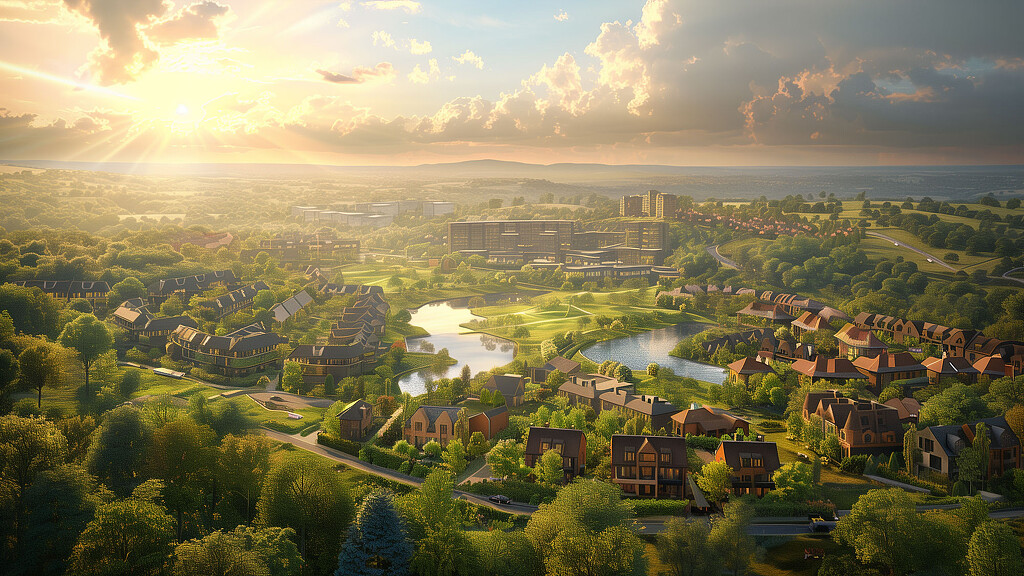Are ‘New Towns’ the Solution to the U.K. Housing Crisis?
June 10, 2024 | By Ian Mulcahey
Editor’s note: This blog post is part of a series introducing several design-driven solutions to address the U.K. housing crisis. Read part 2 here and part 3 here.
The U.K. continues to struggle to provide enough housing for its growing population. The Centre for Cities recently estimated that the U.K. now has a backlog of 4.3 million missing homes from the housing market. In the year 2022-2023, only 234,000 new homes were completed in the U.K. At this rate of construction, it would take 17 years to close the gap. What is of more concern is that, given the National Statistical Office’s latest projection, the U.K. population is set to rise from 67 million today to 70 million by 2025, widening the gap between provision and demand even further. By 2050, it is anticipated that the U.K. will have a population 78 million.
However, this isn’t a problem isolated to the U.K. — this is a global issue. UN-Habitat estimates that by 2030, 3 billion people, some 40% of the world’s population, will need access to adequate housing. So, now is the time for a more radical approach to the provision of housing.
The United Kingdom was once a world leader in the design and delivery of housing. During the 19th century, a period of extraordinary economic growth and change, the U.K. led the way in the creation of the first generation of high-density industrial cities. These cities set a new standard for how to build fast and densely to accommodate the extraordinary urban growth, but they were not without their shortcomings. By the end of the 19th century, new solutions to the continuous, spontaneous metropolitan expansion were being sought.
In 1898, Ebenezer Howard gave birth to a radically new approach with his vision for an entirely new town — or Garden City — to help address the problems of rapid urbanisation. His privately delivered Garden Cities in Letchworth and Welwyn became internationally recognised as a way of delivering new urban housing and hugely influential in municipalities across the world. This innovative thinking was later adopted as part of the government’s solution to the housing crisis in the immediate post-WWII period, in which a combination of bomb-damaged cities and failing urban slums created enormous pressure for a new approach to the provision of housing.
In recent weeks, the ideas for New Towns, sometimes also known as planned communities, are once again on the political agenda. Unlike the New Towns of the 20th century, the more recent suggestion of building New Towns is really a rebadging of the current Garden Communities — a very timid response to a very serious problem. Despite the name, these are not strictly ‘New Towns’ in the traditional sense but are actually suburban extensions to established communities. Some regard them as a further erosion of the one constant in postwar U.K. planning — the ‘Green Belt.’ The argument is that not all the Green Belt is green, and so these areas should be redesignated as ‘Grey Belt’ to be brought forward for housing.
This feels a slightly underwhelming continuation of the status quo under a different name and is probably unlikely to make any serious impact on the growing shortage of housing. The sheer boldness of the original Garden Cities provided a better quality of life more in balance with our natural environment.
The notion of entirely new, free-standing cities, with their own purpose-built infrastructure, agriculture, and employment is exactly what we need now, not further suburban housing estates clinging to the edges of our most popular towns and cities. It feels like the Garden City is ready to be reborn for the 21st century new cities, not for a few thousand people but for a million people, that can comprehensively provide better and more sustainable new communities.
The challenge will be how, and most importantly where, we build these New Garden Cities without destroying the very thing we value so much — our open natural countryside.
For media inquiries, email .

